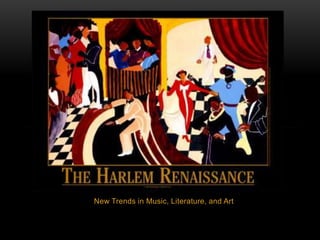
Harlem renaissance
- 1. New Trends in Music, Literature, and Art
- 2. THE GREAT MIGRATION • With the passage of the Jim Crow Laws, the continuation of hate crimes, and the lack of economic stability for African Americans in the South, led them to seek better lives for themselves. • The booming industrial economy of the North attracted many of the African Americans seeking a better opportunity. • Although the Northern legal system did not obstruct the success of African Americans as it did in the South, prejudice from white factory workers still existed. • The new migrants found themselves segregated into urban slums. The largest of these slums being Harlem. • Harlem became the central location of old African American traditions, as well as a breeding ground for new ones. Jim Crow Laws- laws that enforced racial segregation in the South
- 3. MOVERS AND SHAKERS • Langston Hughes- Writer, novelist, poet of the Harlem Renaissance. Promoted the “real” black image and encouraged his followers to not be ashamed of their African roots. He criticized his counterparts for being too “Eurocentric” in their struggle for equality. He helped introduce the new idea of Jazz Poetry in his work. Jazz Poetry- poetry that is read to the accompaniment of jazz music
- 4. PAUSE FOR THOUGHT… • Critical Thinking: What is “Eurocentric?” And why might this approach to equality be criticized?
- 5. MOVERS AND SHAKERS • W. E. B. Du Bois- Graduated from Harvard and was the first African American to receive a Doctorate. • DuBois cofounded the NAACP in 1909. Their mission is to ensure the political, educational, social, and economic equality of rights of all persons and to eliminate racial hatred and racial discrimination. • During the Niagara Movement, DuBois and other activists wrote a declaration opposing the Atlanta Compromise. Not able to publicize their ideals, Dubois purchased his own printing press and established the first African American weekly circulation of Moon Illustrated Weekly. NAACP- National Association for the Advancement of Colored People Niagara Movement- a 1905 call for opposition to the Atlanta Compromise. Atlanta Compromise- An agreement established between African American spokesperson Booker T. Washington and white officials stating that Southern blacks would submit to discrimination, segregation, lack of voting rights, and non- unionized employment; that Southern whites would permit blacks to receive a basic education, some economic opportunities, and justice within the legal system.
- 6. PAUSE FOR THOUGHT… • Critical Thinking- Explain the significance of the Atlanta Compromise and the Niagara Movement.
- 7. MOVERS AND SHAKERS • Zora Neale Hurston- Was a prominent writer of the Harlem Renaissance. She was criticized for her use of dialect fiction in her writings, with objections being aimed toward her use of African American dialect. Most criticism came from her later works where African American critics argued that her use of dialect opposed the overall advancement of colored people and catered to a white audience. Dialect fiction- the use of nonstandard spelling for speech to draw attention to pronunciation
- 8. PAUSE FOR THOUGHT… • “Love is lak de sea. It’s uh movin’ thing, but still and all, it takes its shape from de shore it meets, and it’s different with every shore.” ― Zora Neale Hurston, Their Eyes Were Watching God • Critical Thinking: How might the use of dialect fiction be a positive influence in the advancement of colored people?
- 9. THE JAZZ AGE • Jazz Music- a type of American music with lively rhythms and melodies that are often made up by musicians as they play • The Cotton Club- A nightclub in Harlem. The club was a whites-only establishmen,t even though it featured many of the best black entertainers and jazz musicians • Duke Ellington- Introduced the orchestra or “big band” to jazz music. One of the most notable jazz musicians of all time. Often played at the Cotton Club.
- 10. PAUSE FOR THOUGHT… • http://www.youtube.com/watch?v=7atwjmPcxng • After listening to the clip, are there any elements of the music that sound familiar to today’s music? Discuss with a neighbor.
- 11. FINAL THOUGHT • Using key vocabulary terms from the lecture presentation, how would you define the Harlem Renaissance? What aspects of the Harlem Renaissance do you still see present in our culture today?
